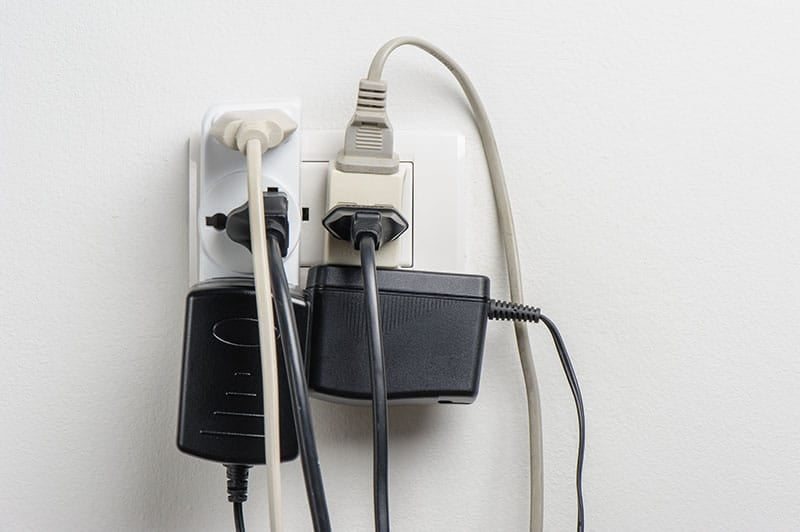Like running up and down the stairs every three minutes to reset the breaker as you’re attempting to vacuum the house? Neither do we!
This article describes 4 key steps to take when your vacuum keeps causing your circuit breaker to trip. It will help you to troubleshoot the situation and offer some safe, intelligent ways to rectify the problem.
Ready? Let’s go!
Why Does My Vacuum Trip My Electrical Breaker?
There are several possible reasons that your circuit breaker is tripping when you run your vacuum cleaner. To understand better, it is good to know about some basic concepts that affect the process.
First, let’s take a look at electrical arcing and what causes it. (No worries. This won’t be too technical.)
What is Electrical Arcing?
An arc is the jumping of electricity. Electrical arcs occur when electricity jumps from one conductor to another.
Traditional electrical breakers respond to arcing differently than Arc Fault Circuit Interrupter (AFCI) breakers.
Vacuums give off some internal arcing in normal operation. This arcing can cause an AFCI breaker to trip. This normal phenomenon is called “nuisance tripping”.
Let’s take a closer look at each of these common types of electrical breakers, and how each may be tripping when you operate your vacuum cleaner.
Traditional vs AFCI Breaker
Circuit breakers are over-current protection devices (OCPDs). They serve to interrupt electrical current from continuing to flow in faulty electrical circuits.
Unlike fuses, electrical breakers do not have to be replaced after interrupting a circuit once. Instead, they can be easily reset, which allows the electrical current to resume flowing.
There are various sizes and types of circuit breakers. Low current breakers protect small household appliances (like a vacuum cleaner), and large breakers are in place to interrupt huge circuits, like those that supply electricity to entire cities.
All circuit breakers are designed to protect a circuit from electrical overload. If a breaker senses an overload in the circuit, it automatically “trips” into the OFF position.

When a breaker trips, it “breaks” the circuit, which disallows electricity from flowing through any longer.
So, what’s the difference between conventional and AFCI breakers?
Traditional circuit breakers are designed to protect a circuit from electrical overload and short circuits. This type of breaker is not able to detect erratic, reduced-current anomalies like arcing.
That’s why Arc Fault Circuit Interrupter breakers are designed. They continuously monitor the circuit not only for overload and short circuits, but also arcing. Hence their name!
AFCI electrical breakers increase safety by reducing the chance of electrical fire due to arcing within a circuit.
Some common causes of electrical arcing are:
- Defective electrical equipment
- Wires with damaged insulative wrapping
- Improperly installed wires inside an electrical panel
- Electrical panels left open and exposed to the elements
- Having too many breakers or fuses in an electrical panel (over fusing)
AFCIs are smart little circuit breakers! They discriminate between normal electrical current and current with undesirable arcing.
If an AFCI breaker senses arcing, it automatically opens its contacts, interrupting the circuit. This de-energizes the circuit until the breaker is reset.
So, if you have conventional (non-AFCI) breakers and the vacuum keeps tripping them, then it’s likely that you may have either:
- Overloaded circuit
- Electrical short circuit
- Defective electrical breaker
If the circuit is overloaded, try turning off all electrical appliances on the circuit besides the vacuum cleaner. Then, try using the vacuum again and see if it continues to trip the breaker. If not, the issue is conquered!
If the breaker continues tripping, you might have a short circuit either in the breaker itself or the vacuum cleaner.
If you think that your conventional electrical breaker is defective or worn out, you should have an experienced electrician test it and replace it if necessary.
If your vacuum keeps tripping your AFCI breaker more often than common “nuisance” trips, the issue likely has something to do with electrical arcing, which could originate in either the vacuum cleaner, the AFCI breaker, or another location along the circuit in question.
So, now that you understand the differences between conventional and arc fault circuit interrupter breakers, let’s get into what this article is all about: Why your vacuum may be tripping your circuit breakers and what you can do about it!
How To Stop Your Vacuum From Tripping The Breaker
Please note that there is no replacement for professional experience, especially when dealing with possibly deadly electricity. So, the first step to determining what is causing your vacuum to keep tripping your breaker is to remember how fast electricity is!
Step #1 Safety First
If you are inspecting your vacuum or any other electrical appliance or device for faulty wiring or another electrical issue, always unplug it first.

If you are inspecting or resetting the breaker to restore your vacuum’s function, be very careful and practice sensible, safe habits around the electrical panel.
If you are unsure about anything you’re attempting to troubleshoot concerning your vacuum or the electrical circuit that feeds it, then please contact a professional electrician or someone else who understands the dangers and intricacies involved.
Step #2 Check the Breaker Box
Sure, you can go ahead and run up or down the stairs every time your vacuum trips the breaker. You can easily reset the breaker, close the panel, and then go down or up the stairs, again, to get back to what you were already doing: vacuuming!
And what if the vacuum keeps tripping the breaker so often that it becomes infuriating?
If your vacuum keeps tripping the breaker, it could be caused by a faulty or defective breaker. Breakers are designed to be tested monthly to ensure proper, safe operation. Many fail to have their breakers tested regularly enough – and some people never have them tested at all!
If the breaker needs to be tested, you should contact someone with expertise in that field to help. However, the problem could also lie in the vacuum or in the electrical outlet that the vacuum plugs into. Let’s look closer.
Step #3 Check the Vacuum Cleaner
Your vacuum cleaner could have an internal problem that’s causing the breaker to trip repetitively.
Unplug the vacuum and visually inspect the cord and plug, looking for frayed wires, holes in the insulative wrapping, or other signs of obvious damage or defect.
If you notice any outward arcing from your vacuum during operation, turn it off, unplug it, and take it to a repair shop immediately. Or just replace it. Vacuum cleaners are not designed to be flamethrowers!
Likewise, you should never smell a burning odor when operating your vacuum. It could be caused by a bent belt pulley causing the belt to burn, or electrical arcing inside that is combusting dust or other materials inside the housing.
If you notice sparks or smell burning when you operate your vacuum cleaner, please get it professionally serviced before continuing to use it.
Step #4 Check the Electrical Outlet
Your vacuum cleaner might be tripping the circuit breaker because of a loose or inappropriate connection with the wall outlet. Visually inspect the vacuum’s cord and plug. Take a close look at the outlet and see if there’s any obvious damage or looseness. Everything should appear bright, tight, and right!
You can also plug the vacuum into a different outlet that is not on the same circuit. If the vacuum operates on a different circuit without tripping the breaker, then at least you’ll know the problem is not with the vacuum cleaner.
Summary & Conclusion
There are several possible culprits to blame when your vacuum cleaner keeps tripping the circuit breaker. It might be the vacuum, the circuit breaker, the wall outlet, or another component of the electrical system that you cannot discern.
Circuit breakers, both conventional and AFCI, can malfunction due to improper installation, old age, or damaged wiring. Electrical breakers are designed for and should be inspected and tested monthly to ensure optimal safety in your electrical system.
If you have taken the steps above and cannot find any obvious problems with the circuit breaker, the vacuum, or the outlet, then you should consult with an electrician.

There’s no substitute for experience, training, and the proper equipment to troubleshoot and solve the problem. And a failure to act can increase the risk of danger from an electrical fire, electrocution, or worse.
Thank you very much for reading this article about what to do when your vacuum keeps tripping your circuit breaker. We hope that you find it helpful. If you did, consider checking out the related articles below!







